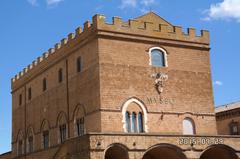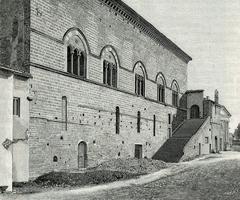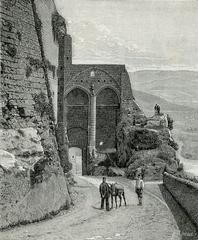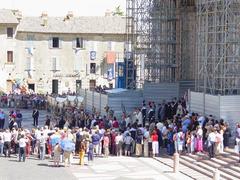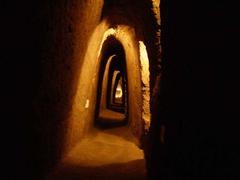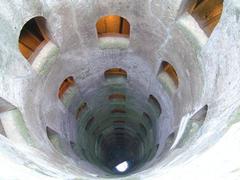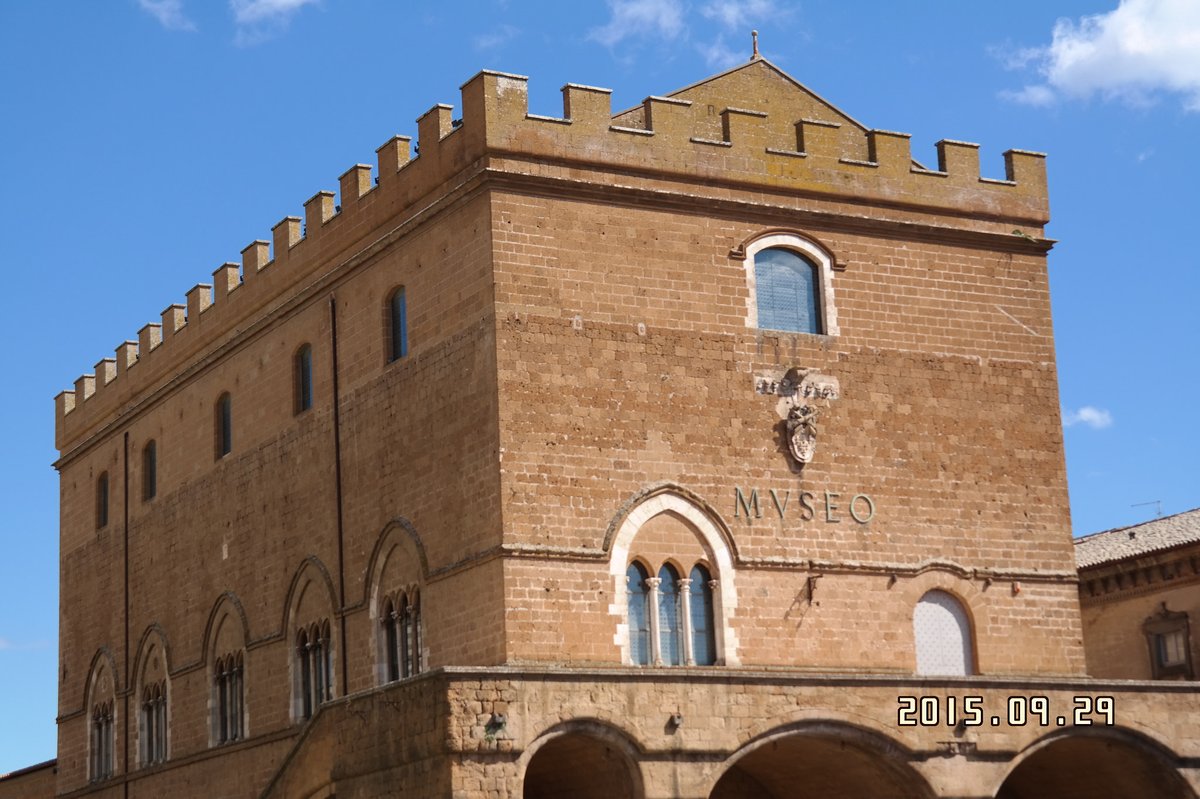
Orvieto Visiting Hours, Tickets, and Historical Sites Guide
Date: 14/06/2025
Introduction
Perched atop a dramatic volcanic tufa plateau in Umbria, Italy, Orvieto is a city that seamlessly blends ancient Etruscan roots, medieval artistry, and profound papal history. Famed for its majestic Gothic cathedral, the Duomo di Orvieto, and its pivotal role as a papal refuge, Orvieto invites visitors to journey through centuries of faith, political intrigue, and cultural innovation. From the celebrated Miracle of Bolsena to the ingenious engineering of St. Patrick’s Well, every corner of Orvieto tells a story of ingenuity and devotion.
This comprehensive guide provides everything you need to plan your visit, including in-depth information on Orvieto’s historical sites, practical details on visiting hours and ticket options, guidance on accessibility, and advice for experiencing local traditions and nearby attractions. Whether you are a history buff, art lover, or simply seeking an authentic Italian experience, Orvieto’s living heritage promises a visit to remember (Umbria Tourism, National Catholic Register, Orvieto Viva).
Historical Highlights and Papal Legacy
Etruscan Origins and Medieval Transformation
Orvieto’s story begins with the Etruscans, who established the city as Velzna, a major religious and political hub. Remnants of this ancient civilization can be explored at the Necropolises of Crocifisso del Tufo and Cannicella, as well as the archaeological site of Campo della Fiera. During the Middle Ages, Orvieto evolved into a Free Commune before coming under papal control in the 12th century, becoming a vital Guelph stronghold and papal refuge.
Papal Influence
Between the 13th and 14th centuries, Orvieto hosted several popes including Urban IV, Gregory X, Martin IV, Nicholas IV, and Boniface VIII, shaping its architectural and spiritual landscape. The Duomo di Orvieto and the Papal Palace (Palazzo Soliano) stand as enduring symbols of this legacy (National Catholic Register). Defensive structures like the Fortezza Albornoz and St. Patrick’s Well reflect the city’s strategic importance and papal foresight in times of unrest.
Top Historical Sites in Orvieto
Duomo di Orvieto
- Visiting Hours: Daily, 8:30 AM–7:00 PM (last entry at 6:30 PM). Hours may vary on holidays.
- Tickets: Approx. €3 for adults; combined tickets with Museo dell’Opera del Duomo and St. Patrick’s Well available for €12 (Orvieto Viva).
- Highlights: The façade features golden mosaics and bas-reliefs; inside, the San Brizio Chapel is renowned for Luca Signorelli’s frescoes and the Chapel of the Corporal houses the miracle relic (thegeographicalcure.com).
Palazzo Soliano (Papal Palace)
- Visiting Hours: Tuesday–Sunday, 10:00 AM–6:00 PM.
- Tickets: Around €7, includes access to National Archaeological Museum exhibits.
- Significance: Former papal residence and administrative center, now a museum featuring frescoes, sculptures, and ecclesiastical artifacts.
Fortezza Albornoz
- Visiting Hours: 10:00 AM–5:00 PM.
- Tickets: Free entry.
- Experience: Enjoy panoramic views and learn about Orvieto’s military history.
Pozzo di San Patrizio (St. Patrick’s Well)
- Visiting Hours: 9:00 AM–7:00 PM.
- Tickets: Approx. €5; included in some combined tickets.
- Features: A 62-meter-deep well with a double-helix staircase, commissioned by Pope Clement VII during his refuge from Rome (Don Knebel).
Orvieto Underground
- Tour Hours: Tours typically at 11:00 AM, 12:15 PM, 4:00 PM, and 5:15 PM; more frequent in high season.
- Tickets: €8 per person (orvietoviva.com).
- Experience: Guided tours through Etruscan and medieval tunnels, wells, and cisterns highlight Orvieto’s subterranean ingenuity.
Other Notable Sites
- City Gates and Statues: Statues of Pope Boniface VIII at gates such as Porta Maggiore are accessible at all times.
- Palazzo del Popolo: Former seat of civic government, now a venue for cultural events and exhibitions.
Practical Visitor Information
Tickets and Passes
The Orvieto Card (Carta Unica) offers combined entry to main sites including the Duomo, underground, St. Patrick’s Well, and more. Cost: approx. €15. Purchase at the train station, tourism office (Piazza del Duomo), or online (Orvieto Viva).
Getting Around
Orvieto’s historic center is walkable. The funicular from the lower town (train station) to Piazza Cahen provides easy access. Shuttle buses and escalators are available for those with mobility needs. Limited parking is available at Piazza Cahen and Campo della Fiera (Invitation to Tuscany).
Accessibility
Major sites like the Duomo and Museo dell’Opera are wheelchair accessible. However, St. Patrick’s Well and parts of the underground have steep stairs and uneven terrain (My Adventures Across the World).
Guided Tours and Events
Guided tours are recommended for the Duomo, underground, and city highlights (umbriaconme.com). The Corpus Domini procession in June and Umbria Jazz Winter in December are major events.
Nearby Attractions
Popular day trips include Civita di Bagnoregio, Todi, and Spoleto (Strictly Italy). The Umbrian countryside offers opportunities for wine tasting and exploring local cuisine.
Cultural Insights
Papal Heritage and Local Identity
Orvieto’s role as a papal sanctuary shaped its architecture and traditions. The presence of the papacy fostered artistic patronage and prosperity, still visible in the city’s grand palaces and the Duomo’s splendor (Wikipedia, Invitation to Tuscany).
Religious Traditions and Festivals
The Miracle of Bolsena and the annual Feast of Corpus Christi define Orvieto’s religious calendar, celebrated with vibrant processions and festivities (The Catholic Travel Guide). Local crafts, especially ceramics, and food festivals are an integral part of cultural life (Mama Loves Italy).
Daily Life and Gastronomy
Piazzas like Piazza della Repubblica and Piazza del Popolo are lively community hubs. Orvieto is renowned for hearty Umbrian cuisine and Orvieto Classico white wine (Tourist Places Guide). Try local specialties such as wild boar ragù and truffle-infused dishes.
Art, Architecture, and the Underground
Marvel at the Duomo’s mosaics and Signorelli’s frescoes (PlanetWare), and discover Etruscan tunnels and the Pozzo di San Patrizio on guided underground tours (Mama Loves Italy).
Frequently Asked Questions (FAQ)
Q: What are the visiting hours for the Duomo di Orvieto?
A: Daily from 8:30 AM to 7:00 PM; hours may vary on holidays.
Q: How much are tickets for main attractions?
A: Duomo: €3; Orvieto Underground: €8; St. Patrick’s Well: €5; Orvieto Card (combined sites): €15.
Q: How do I get to Orvieto?
A: By train from Rome or Florence (about 1–1.5 hours); take the funicular from Orvieto Scalo to the historic center.
Q: Is Orvieto accessible for visitors with mobility challenges?
A: The center and most major sites are accessible; however, the underground and St. Patrick’s Well have limited accessibility due to stairs.
Q: Are guided tours recommended?
A: Yes, especially for the cathedral, underground, and historical highlights.
Q: When is the best time to visit?
A: Spring (April–June) and autumn (September–October) for mild weather and fewer crowds.
Tips for a Memorable Visit
- Book Tickets in Advance: Especially for the Duomo, underground tours, and St. Patrick’s Well during peak seasons.
- Arrive Early: To avoid crowds and experience a peaceful atmosphere.
- Dress Respectfully: Shoulders and knees must be covered in religious sites.
- Plan for Siesta: Many shops and restaurants close in the afternoon.
- Wear Comfortable Shoes: Cobblestones and hills make sturdy footwear essential.
- Sample Local Food & Wine: Don’t miss Orvieto Classico and regional specialties.
- Check Event Calendars: Attend festivals like Corpus Domini and Umbria Jazz Winter for a unique cultural experience.
Visuals and Media
For an enhanced experience, view or share:
- Photos of the Duomo’s façade (alt text: “Duomo di Orvieto Gothic Cathedral façade”)
- Signorelli’s frescoes (alt text: “Luca Signorelli frescoes inside Orvieto Cathedral”)
- The Pozzo di San Patrizio stairwell (alt text: “St. Patrick’s Well double-helix staircase in Orvieto”)
- Maps of Orvieto highlighting major attractions and transport links.
Internal Links
Summary
Orvieto is a city where history, faith, and artistry intersect. Its papal heritage is alive in monumental sites like the Duomo and St. Patrick’s Well, while its lively piazzas, traditional festivals, and culinary delights offer a vibrant modern-day experience. With accessible visitor amenities, efficient transport, and comprehensive ticket options, Orvieto is an ideal destination for immersive Italian travel. Plan ahead, use digital resources like the Audiala app, and savor every moment in this remarkable hilltop city (Orvieto Info, Audiala, Mama Loves Italy).
Sources
- Umbria Tourism
- National Catholic Register
- Mama Loves Italy
- Strictly Italy
- Invitation to Tuscany
- The Catholic Travel Guide
- PlanetWare
- Orvieto Viva
- Audiala
